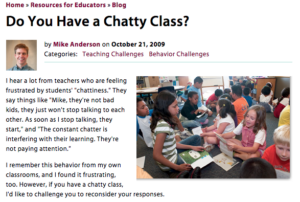Do You Have a Chatty Class?
Original Article: https://www.responsiveclassroom.org/blog/do-you-have-chatty-class
 I hear a lot from teachers who are feeling frustrated by students’ “chattiness.” They say things like “Mike, they’re not bad kids, they just won’t stop talking to each other. As soon as I stop talking, they start,” and “The constant chatter is interfering with their learning. They’re not paying attention.”
I hear a lot from teachers who are feeling frustrated by students’ “chattiness.” They say things like “Mike, they’re not bad kids, they just won’t stop talking to each other. As soon as I stop talking, they start,” and “The constant chatter is interfering with their learning. They’re not paying attention.”
I remember this behavior from my own classrooms, and I found it frustrating, too. However, if you have a chatty class, I’d like to challenge you to reconsider your responses.
As the teacher, you may be focused on teaching reading, writing, math, etc.—but for students, school is as much about socializing as it is about the academic stuff—and there’s a heck of lot of learning happening in the course of the social stuff! If you can direct and use kids’ social energy in positive ways in your classroom, you’ll be much less frustrated than if you focus on trying to keep them quiet.
Here are some specific suggestions:
- Can you leverage the chattiness?
Students need to talk, so give them what they need! Use partner chats and other interactive learning structures to have them deepen their understanding of lessons. For example, while teaching a lesson about using descriptive language in writing, have pairs of students chat about topics you suggest: “What are some descriptive words you could use to describe today’s weather (or our classroom, or our class goldfish, etc.)?” - Would changing your room design help?
Are students crammed together in the middle of the room? Creating extra space between tables and desks can help students stay more focused on their work. Consider breaking up the work areas so that tables or clusters of desks are spread out. For example, you could move a table for four students against a wall and put a supply shelf or bookshelf (not too tall) in the middle of the room. (Check out Classroom Spaces That Work and the books in the What Every Teacher Needs to Know K–5 Series for more ideas.) - Are your lessons short enough?
Try to keep direct instruction time to 10 minutes or less. If you have multiple teaching points, try breaking them up into separate lessons. - Could you add more movement?
Consider teaching lessons in one area and then having students do work at their seats. A change of scenery and movement can help them stay focused. You could also include someenergizers and game breaks throughout the day to keep students energetic and engaged. - Are learning activities enjoyable?
If you were a student in your class, would you be having fun with the assignments? Make sure students have some power and control over their learning by giving them somechoices about what they learn or how they learn it. I recently watched a very energetic group of second graders sustain focused engagement for thirty-five straight minutes because they were excited about and invested in the science projects they were working on. - Do you have a clear, consistent way of responding to misbehavior?
Sometimes, even when we state our expectations clearly and use lots of the proactive strategies listed above, students will still talk when they shouldn’t. When this happens, get them back on track through logical consequences.
Most of all, though, remember that students need to talk for the same reasons we need to talk: to interact with others, to share ideas, to meet their needs for belonging, significance, and fun, to ask questions. Think of how hard it is for us as teachers to not have side conversations at staff meetings!




